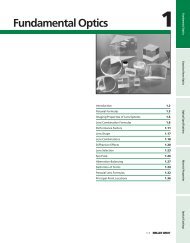Intel PXA250 and PXA210 Applications Processors
Intel PXA250 and PXA210 Applications Processors
Intel PXA250 and PXA210 Applications Processors
Create successful ePaper yourself
Turn your PDF publications into a flip-book with our unique Google optimized e-Paper software.
SA-1110/<strong>Applications</strong> Processor Migration<br />
You can program GPIO pins to generate various clocks in both the SA-1110 <strong>and</strong> the <strong>PXA250</strong><br />
applications processors. For example, these are often used in audio codec designs to generate<br />
clocks. The inter-relationships of some of these clocks have changed from the SA-1110 to the<br />
<strong>PXA250</strong> applications processor. You may need to select different GPIO pins <strong>and</strong> program different<br />
configuration registers to provide similar functionality.<br />
A.1.6<br />
UCB1300<br />
The SA-1110 supports a unique serial protocol for communication with the Philip’s UCB product<br />
family: UCB1100, 1200 <strong>and</strong> 1300. This serial interface is not available on the <strong>PXA250</strong><br />
applications processor. Instead the <strong>PXA250</strong> applications processor supports several industry<br />
st<strong>and</strong>ard Audio codec Interfaces. You may also use I 2 S/I 2 C combinations <strong>and</strong> an AC’97 interface.<br />
If an SA-1110 design utilizes this UCB interface then an alternative choice of components is<br />
necessary for the <strong>PXA250</strong> applications processor.<br />
A.2 SA-1110 to <strong>PXA250</strong> Software Migration Issues<br />
The difficulty of migrating software from the SA-1110 to the <strong>PXA250</strong> applications processor<br />
depends on the amount of hardware <strong>and</strong> software interaction. SA-1110 applications running under<br />
an Operating System, which use device driver interfaces, should move seamlessly between the two<br />
devices.<br />
There is one exception; any application that explicitly uses the Read Buffer to prefetch external<br />
memory data into the SA-1110. This buffer does not exist on the <strong>PXA250</strong> applications processor<br />
<strong>and</strong> register #9 in Coprocessor #15 that was used to access it are not compatible to software.<br />
As the Read Buffer prefetching activity was deemed to be a hint rather than an instruction,<br />
applications can simply delete all references to the Read Buffer <strong>and</strong> still function correctly. They<br />
may not even suffer a performance penalty, as the <strong>PXA250</strong> ’hit-under-miss’ cache feature can turn<br />
the entire data space into a prefetchable region without any explicit software direction.<br />
Alternately, as a patch for software that cannot be modified, all applications must be limited to<br />
User Mode execution, whereupon an Exception can be generated for all Coprocessor activity.<br />
Such an exception manager needs to filter out the Read Buffer coprocessor calls, or convert them to<br />
<strong>PXA250</strong> PLD instructions that can preload a data cache value.<br />
There are major software difference within the device initialization/configuration software <strong>and</strong><br />
device drivers, such as low-level code that controls the hardware.<br />
The <strong>PXA250</strong> applications processor has enhanced functionality <strong>and</strong> extra instructions not found in<br />
the SA-1110. The <strong>PXA250</strong> applications processor software is not backward compatibility to the<br />
SA-1110. Once code is compiled for the <strong>PXA250</strong> applications processor it is unlikely to run on the<br />
SA-1110.<br />
<strong>PXA250</strong> <strong>and</strong> <strong>PXA210</strong> <strong>Applications</strong> <strong>Processors</strong> Design Guide A-5
















